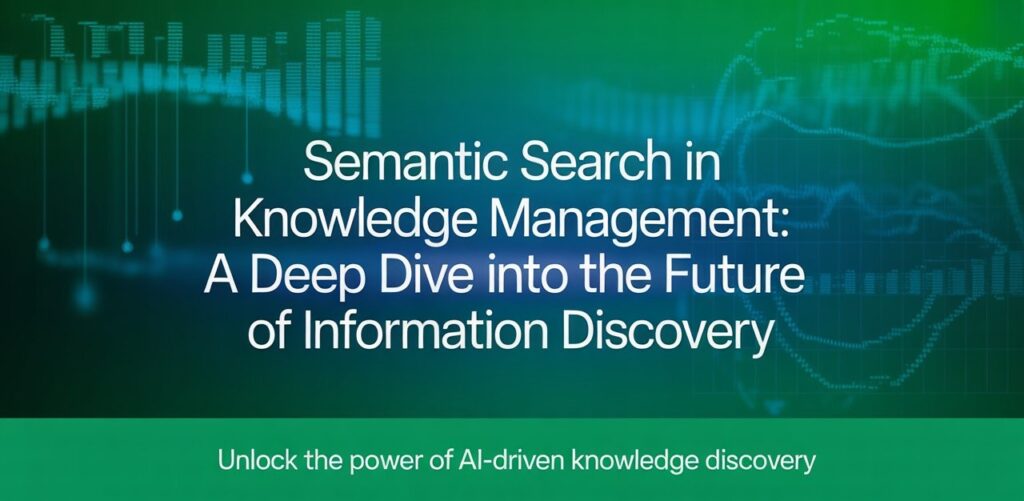Semantic search in knowledge management is redefining how enterprises interact with information. By moving beyond keyword-based search, semantic systems understand the intent, context, and relationships between concepts. This shift transforms how employees find knowledge, solve problems, and make decisions.

What is Semantic Search in Knowledge Management?
Semantic search in knowledge management refers to the ability of KM systems to retrieve information based on meaning and context, not just exact keyword matches. This is achieved using AI technologies like:
- Natural Language Processing (NLP)
- Machine Learning (ML)
- Vector embeddings
- Knowledge graphs
These tools work together to interpret user queries more intelligently and match them with relevant, related content — even if the exact keywords are not present.
How Traditional Search Falls Short
Traditional search systems rely on exact keyword matching. For example, a query like “employee onboarding document” might miss highly relevant documents titled “training guide for new hires.” This leads to:
- Missed knowledge
- Frustrated users
- Lower productivity
Semantic search addresses these challenges by recognizing synonyms, related terms, and conceptual connections.
How Semantic Search Works in KM
- Intent Detection: NLP engines analyze the user query to understand what the user actually wants to find.
- Contextual Matching: Vector-based models compare the semantic meaning of the query against stored documents.
- Knowledge Graph Integration: Connections between concepts, people, and documents enhance relevance.
- Learning Feedback Loops: User behavior data helps refine future search results.
Key Technologies Behind Semantic KM
- Vector Search Engines: Tools like Pinecone, Weaviate, and Elasticsearch with vector plugins power semantic similarity matching.
- LLMs & Transformers: Models like BERT or GPT understand language context better than traditional models.
- Graph Databases: Neo4j or Stardog help link related knowledge through knowledge graphs.
Real-World Applications
1. IBM Watson Discovery
IBM uses semantic AI to help internal teams and clients extract insights from vast repositories of unstructured data. Semantic understanding helps Watson deliver precise, context-aware answers.
2. Google Vertex AI Search
Google offers semantic enterprise search as a service, helping businesses build custom search experiences with contextual ranking, intent detection, and natural language question answering.
3. Deloitte KX (Knowledge Exchange)
Deloitte enables consultants to retrieve tax, compliance, and client insights quickly. Its semantic platform reduces time spent searching by 40%.
Benefits of Semantic Search in KM
- Improved Relevance: Finds information that matters, not just what matches keywords.
- Knowledge Discovery: Surfaces previously hidden or forgotten content.
- Enhanced Productivity: Employees spend less time searching and more time acting.
- Personalized Results: Learns user preferences and tailors results.
Challenges in Adopting Semantic Search
- Data Silos: Fragmented content repositories reduce semantic accuracy.
- Implementation Cost: AI-based search requires infrastructure investment.
- Change Management: Employees may need training to trust and use new systems.
Overcoming These Challenges
- Centralize Knowledge Repositories to improve access.
- Invest in Scalable AI Platforms like AWS, GCP, or Azure for semantic infrastructure.
- Offer Training & Support to ensure adoption and trust in semantic systems.
Step-by-Step Implementation Guide
- Audit Your KM Content: Identify where your knowledge lives and assess quality.
- Select Semantic Search Tools: Choose from platforms like Lucidworks, Microsoft Viva, or Sinequa.
- Integrate with Existing Systems: Connect SharePoint, Confluence, CRM, etc.
- Build a Knowledge Graph: Model how knowledge elements are related.
- Train NLP Models: Use internal data to improve intent understanding.
- Monitor & Iterate: Collect feedback and refine over time.
Tool Comparison Table
| Tool | Features | Strengths | Best For |
|---|---|---|---|
| Microsoft Viva | AI-powered search, integration with M365 | Seamless for Microsoft users | Large enterprises using SharePoint |
| Lucidworks Fusion | NLP, ML ranking, connectors | Scalable & customizable | Enterprise KM platforms |
| Sinequa | Semantic AI, connectors, analytics | Rich UI and insights | Compliance-heavy industries |
| Elastic + NLP | Open-source, customizable | Affordable & flexible | Developers, startups |
| Google Vertex AI Search | LLM-powered, scalable | Natural language Q&A | Cloud-native businesses |
Metrics Improved by Semantic KM
- Time to Information: Reduced by up to 50%
- Search Satisfaction Rate: Up by 35–60%
- Knowledge Reuse: Greater accessibility improves reusability
- Content Engagement: Semantic discovery increases interaction
Use Cases by Industry
- Healthcare: Doctors access treatment protocols instantly.
- Legal: Lawyers retrieve case law interpretations contextually.
- Finance: Analysts search regulations and risk guidelines with precision.
- IT: Engineers find code, architecture docs, and incident reports fast.
Final Thought
Semantic search in knowledge management is not just a trend — it’s the new baseline. In an age of growing information overload, organizations that invest in intelligent, AI-powered search will outperform in agility, innovation, and decision-making.
Frequently Asked Questions
👉 Also read: Top AI-Powered Knowledge Management Software for 2025
Disclaimer: Platform capabilities may change over time. Always validate specific features with vendors before implementation.
Subscribe to receive notifications for free webinars on Knowledge Management.
